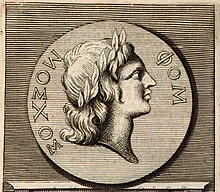46:
99:
319:
243:
341:
137:) is short on pastoral themes and is largely erotic and mythological; although this impression may be distorted by the paucity of evidence, it is also seen in the surviving bucolic of the generations after Moschus, including the work of
149:
has often received separate scholarly editions, as by
Winfried Bühler (Wiesbaden 1960) and Malcolm Campbell (Hildesheim 1991). The epigram is also normally published with the edition by
187:. Although it is hard to tell because of the fragmentary nature of the evidence, Moschus' influence on Greek bucolic poetry is likely to have been significant; the influence of
207:
Two other poems, attributed to him at one time or another but no longer thought to be his, are also commonly edited with his work. The best known is the
263:
258:
191:
is felt in Bion and other later bucolic poets. In later
European literature his work was imitated or translated by such authors as
425:
415:
391:
Poetae bucolici et didactici. Theocritus, Bion, Moschus, Nicander, Oppianus, Marcellus de piscibus, poeta de herbis
410:
141:. Moschus' poetry is typically edited along with other bucolic poets, as in the commonly used Oxford text by
374:
420:
362:
280:
381:
Theocritus, Bion et
Moschus graece et latine. Accedunt virorum doctorum animadversiones scholia, indices
430:
384:
75:
87:
368:
17:
98:
45:
318:
8:
231:), consisting of an epic dialogue between Heracles' mother and his wife on his absence.
224:
130:
118:
394:
336:
323:
150:
215:), which had a long history of influence on the pastoral lament for a poet (compare
345:
393:, C. Fr. Ameis, F. S. Lehrs (ed.), Parisiis, editore Ambrosio Firmin Didot, 1862,
383:, L. F. Heindorfius (ed.), Londini, sumtibus Whittaker, Treacher, et Arnot, 1829,
154:
79:
332:
300:
289:
212:
192:
138:
57:
350:
404:
254:
249:
175:
83:
65:
142:
86:, and flourished about 150 BC. Aside from his poetry, he was known for his
35:
356:
285:
216:
180:
170:
134:
327:
293:
196:
129:
couplets. His surviving bucolic material (composed in the traditional
39:
228:
184:
110:
248:
This article incorporates text from a publication now in the
126:
68:
305:
Geschichte der griechischen
Litteratur in der Alexandrinerzeit.
31:
71:
183:, is a major example of the Hellenistic phenomenon of the
121:, three bucolic fragments and a whole short bucolic poem
271:For a recent overview of Moschus see A. Porro in
102:Page from a 15th-century Byzantine manuscript of
402:
278:There are English translations by J. Banks in
267:(11th ed.). Cambridge University Press.
74:and student of the Alexandrian grammarian
34:. For the 6th century Syrian writer, see
253:
97:
44:
14:
403:
109:His few surviving works consist of an
223:). The other is a miniature epic on
24:
90:work, nothing of which survives.
25:
442:
364:Anacreon, Bion, and Moschus, etc.
357:Works of Moschus at Theoi Project
311:
359:translated by J.M. Edmonds, 1912
317:
241:
49:18th century likeness of Moschus
375:Europa. Perseus Digital Library
30:For the Phoenician writer, see
13:
1:
202:
160:
7:
426:Ancient Greek bucolic poets
179:and such Latin examples as
10:
447:
416:2nd-century BC Greek poets
234:
29:
342:Works by or about Moschus
76:Aristarchus of Samothrace
61:
27:2nd century BC Greek poet
281:Bohn's Classical Library
93:
264:Encyclopædia Britannica
411:Poets of Magna Graecia
288:(1889), together with
106:
50:
101:
48:
38:. For the genus, see
353:English translations
125:, and an epigram in
131:dactylic hexameters
421:Ancient Syracusans
322:Works by or about
107:
51:
431:Hellenistic poets
337:Project Gutenberg
275:10 (1999) 125–25.
151:Maximos Planoudes
117:, on the myth of
78:. He was born at
16:(Redirected from
438:
385:vol. 2 pp. 35-77
351:Poems by Moschus
346:Internet Archive
333:Works by Moschus
321:
268:
247:
245:
244:
145:(1952), but the
63:
21:
446:
445:
441:
440:
439:
437:
436:
435:
401:
400:
314:
284:(1853), and by
257:, ed. (1911). "
242:
240:
237:
209:Epitaph on Bion
205:
163:
155:Greek Anthology
96:
43:
28:
23:
22:
15:
12:
11:
5:
444:
434:
433:
428:
423:
418:
413:
399:
398:
388:
378:
372:
369:Thomas Stanley
367:translated by
360:
354:
348:
339:
330:
313:
312:External links
310:
309:
308:
307:i. 231 (1891).
301:Franz Susemihl
297:
290:Bion of Smyrna
276:
269:
255:Chisholm, Hugh
236:
233:
213:Bion of Smyrna
204:
201:
193:Torquato Tasso
162:
159:
139:Bion of Smyrna
95:
92:
26:
9:
6:
4:
3:
2:
443:
432:
429:
427:
424:
422:
419:
417:
414:
412:
409:
408:
406:
396:
392:
389:
386:
382:
379:
376:
373:
370:
366:
365:
361:
358:
355:
352:
349:
347:
343:
340:
338:
334:
331:
329:
325:
320:
316:
315:
306:
302:
298:
295:
291:
287:
283:
282:
277:
274:
270:
266:
265:
260:
256:
251:
250:public domain
239:
238:
232:
230:
227:(the wife of
226:
222:
218:
214:
210:
200:
198:
194:
190:
186:
182:
178:
177:
172:
169:, along with
168:
158:
156:
152:
148:
144:
140:
136:
135:Doric dialect
132:
128:
124:
120:
116:
112:
105:
100:
91:
89:
85:
84:Magna Graecia
81:
77:
73:
70:
67:
66:ancient Greek
59:
55:
47:
41:
37:
33:
19:
390:
380:
363:
304:
279:
272:
262:
220:
208:
206:
189:Runaway Love
188:
174:
166:
164:
146:
143:A. S. F. Gow
123:Runaway Love
122:
114:
108:
103:
53:
52:
36:John Moschus
286:Andrew Lang
181:Catullus 64
171:Callimachus
88:grammatical
405:Categories
328:Wikisource
294:Theocritus
197:Ben Jonson
395:pp. 77-86
299:See also
203:Apocrypha
161:Influence
64:) was an
40:Musk deer
273:Eikasmos
229:Heracles
185:epyllion
111:epyllion
80:Syracuse
344:at the
324:Moschus
259:Moschus
252::
235:Sources
221:Lycidas
153:of the
127:elegiac
69:bucolic
54:Moschus
18:Moschos
371:(1651)
246:
225:Megara
217:Milton
211:(i.e.
176:Hecale
167:Europa
147:Europa
119:Europa
115:Europa
113:, the
104:Europa
62:Μόσχος
32:Mochus
377:Greek
94:Works
58:Greek
292:and
195:and
165:The
133:and
72:poet
335:at
326:at
261:".
219:'s
199:.
157:.
407::
303:,
173:'
82:,
60::
397:.
387:.
296:.
56:(
42:.
20:)
Text is available under the Creative Commons Attribution-ShareAlike License. Additional terms may apply.

